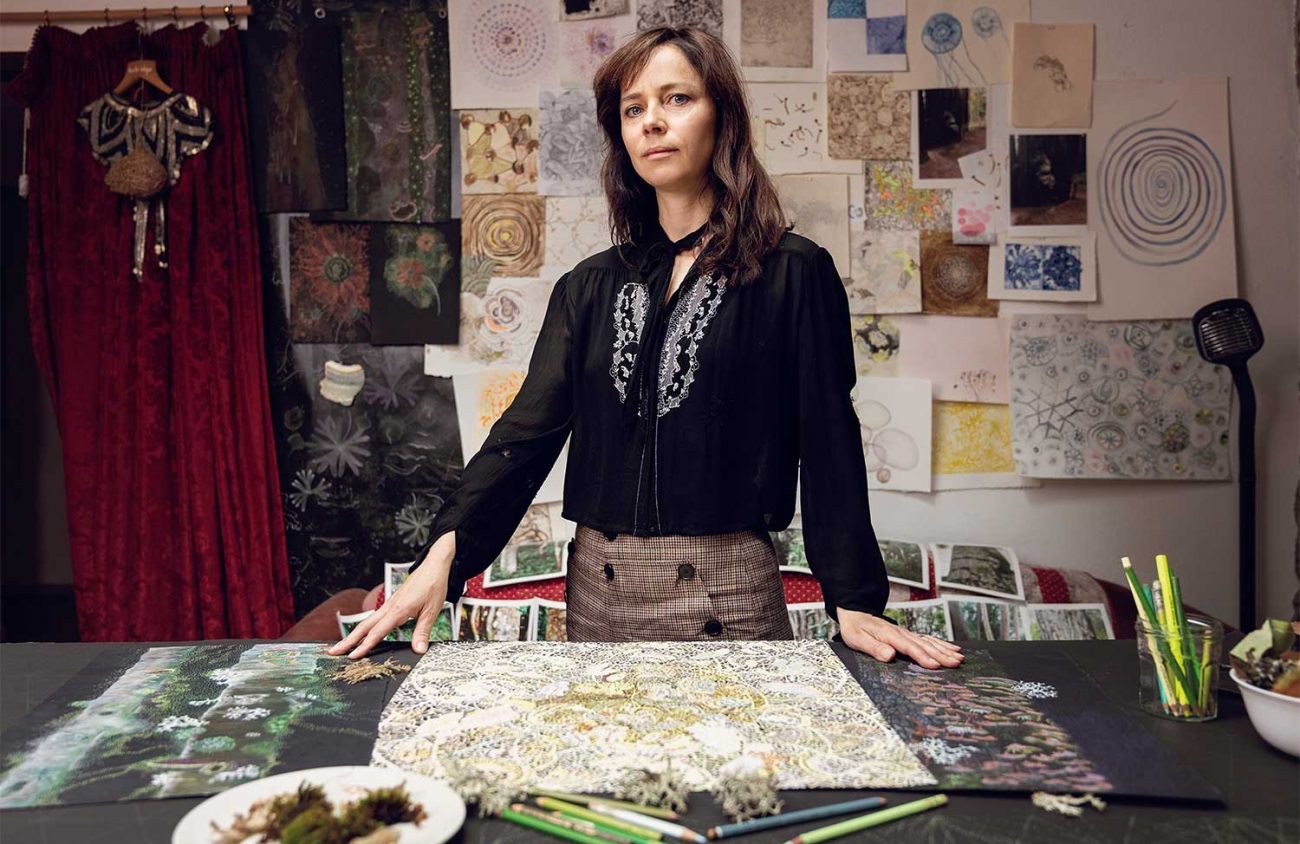Claire Burbridge is moved by small things. Her drawings in Claire Burbridge: Pathways to the Invisible at the Jordan Schnitzer Museum of Art are of natural things you can pick up and look at closely: leaves, insects, flowers, lichen, a sea urchin shell.
Trained as a printmaker, Burbridge primarily employs pencil and ink in this show, tools typically used to create the kind of detail associated with scientific illustrations. She uses these mediums with an illustrative approach, building up value with pointillism, for example, but also uses the technique to create abstract design.
Her illustrative approach defies expectations mostly by the scale of her works. Scientific illustrations of nature are normally meant for small works designed for publication. Her drawings blow up to the size of a wall.
In “The Nocturnal Life of Trees” — a drawing made with colored pencil, pen and ink — trees stretch practically from the floor to the ceiling. One wall in the exhibit is entirely covered with wallpaper inspired by the artist’s studies of nature.
Her studies are of things we might pass by — or step on — during a hike. Then, in her larger works, these objects are transformed by pattern and design. She is particularly attracted to spherical forms. Plenty of those are to be found in nature, such as the ones pictured in “Lichen Drawing” (2019). Done in pen and ink, this all-over pattern depicting variations of circular shapes was acquired by Western Oregon University through Oregon’s Percent for Art in Public Places Program.
In “Insect Universe” (2015), Burbridge draws a variety of insects inside a large circular design. Pointillism is used to great effect in this work. The title tells you to look for individual insects hidden within the sphere. The technique of using points along with straight lines helps to create the illusion that the whole piece is shimmering — flapping its wings.
The exhibit is located in the Artist Project Space at the museum, a gallery with two small rooms. In Burbridge’s exhibit, one room is light and the other dark. The lighter room features smaller works or studies. It houses a display case containing examples of things from nature you might find in the forest around Ashland, where Burbridge lives: butterflies and moths, rocks, branches and lichen.
The light and dark rooms mirror the theme of day and night seen in Burbridge’s art. The pictures done on black paper or in dark tones can sometimes be hard to see. Not being able to easily see the subject seems like it would be a concern, until you realize… isn’t that the way it is at night? Hard to see?
Artists drawing from nature are often highly focused on getting the light right. They usually go out of their way to get good light, to bring out contrasts for drama that might add to the appearance of three-dimensionality on paper. Burbridge spent years as a sculptor before returning to drawing, but clearly her concern is not tied to creating a sculptural element, especially not in her darker pieces.
Her stated goal is “to draw attention to the mysteries of the physical world.”
Thankfully there is a place to sit in the darker room, allowing you to spend some time among her larger works. Sitting there a while you will be drawn into her world. It is one that, as she says, is filled with “many strange, fascinating and abstract forms.”
I looked at the art in this room first before I saw the display case in the other. There I had that wonderful experience you get when an artist influences the way you see. A small nest in the display case — a round shape made of lines — seemed like it could have been made by the artist. It wasn’t, of course. It was made by a nonhuman animal. But after seeing her art, I understood why she might have chosen it to be in the show.
Speaking of science and art, Albert Einstein said this: “The most beautiful thing we can experience is the mysterious. It is the source of all true art and science.” He equated mystery with beauty — and so does Burbridge. She shares with the late, great scientist the idea that mystery is beautiful. It’s the concept at the center of her work. ν
Claire Burbridge: Pathways to the Invisible runs through April 19 at the Jordan Schnitzer Museum of Art at the University of Oregon.
